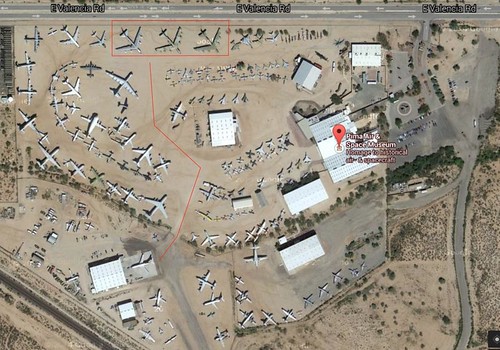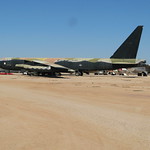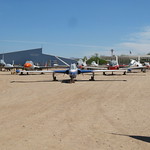During most of the years I flew fighters and trainers for the USAF, I never paid much thought to the disposition of aircraft on the ramp. We parked them when we were through with them; if maintenance needed to move them around on the ground afterward that was their problem. I was of course aware of the importance of making sure aircraft on the ground have adequate room and wingtip clearance for parking and taxiing, but that was the extent of my interest.

Most USAF bases house multiple types of aircraft, some large, some small; typically aircraft are grouped on the ramp by type or size … parking big bombers or air refueling tankers between tightly-packed rows of fighters is just asking for trouble, so to the extent you can you separate differently-sized aircraft.
That’s how we did it at Kadena Air Base in Okinawa, Japan. The F-15s were housed on the northeast side of the runways; the air-refueling tankers, AWACS aircraft and SR-71s were housed on the southwest side. Each side had its own network of taxiways.
We exercised often at Kadena, preparing for possible conflicts and contingencies. One memorable exercise included an airfield damage scenario: in that scenario the southwestern side of Kadena had been bombed and all the aircraft had to operate from the northeast side, the one normally reserved for fighters.
The exercise planners put a lot of thought into how they’d manage the parking and taxi flow of small jets and big jets, but no one thought about the helicopters. In addition to the aircraft already mentioned, Kadena was home to a combat rescue helicopter unit flying Jolly Greens. During the exercise the helo squadron moved from the “damaged” side of the field, which they normally shared with the large aircraft, to the fighter side. But unlike the tankers, which for the exercise were parked at one end of the fighter ramp, the helos wound up with the F-15s at the other end, parked on a taxiway between two rows of covered F-15 shelters. The taxiway had been built for F-15s, of course, but the helos fit, so that’s where they parked them.
On one edge of that taxiway was a tall metal light post. No F-15 had ever come close to it, because when we taxied we put our nose wheels on the yellow painted directional stripes, tailored to our 43′ wingspan, and followed them. When the helos were moved to the F-15 ramp, they were towed there with their rotors folded back along the length of the aircraft. Had their rotors been extended, perhaps someone would have noticed the Jolly is considerably wider than an F-15. The very first time a Jolly crew cranked one up and started taxiing down the yellow stripe in the center of the taxiway, the spinning 79′ diameter rotors hit the post.
Shards of rotor blade shot out in every direction, slicing into parked F-15s and various vehicles. One unfortunate airman, a mechanic working on an F-15, was killed when part of a blade went through his torso. One of the helo pilots was knocked out when the stumps of the still-spinning rotors smashed the top of the cockpit above his head. As the engines continued to run what remained of the rotor kept spinning, with hunks of scrapnel flying out in all directions. Eventually one brave fireman managed to reach the damaged cockpit and secure the engines. The helicopter was destroyed.
No one saw that one coming. And no one who was there will ever forget it. My appreciation for the art and discipline of parking and moving aircraft on crowded airfields, as you may well guess, increased tenfold overnight.
So perhaps you’ll forgive my geeky interest in aircraft exhibit movements at the Pima Air & Space Museum, where I’m a volunteer docent.

Here’s what’s going on at PASM right now. We’re repainting and refurbishing our B-52 bombers (the large aircraft in the red box, above). First, though, the Buffs have to be towed to the restoration hangar at the bottom left of the photo. The approximate path to the restoration hangar is indicated by the red line. As you can see, a lot of aircraft have to be moved first, starting with all those small fighters and trainers parked in front of the bombers, but also several of the larger aircraft on either side of the tow path, which have to be moved back to widen the path.
When I went in yesterday to lead my weekly walking tours, restoration volunteers had moved 20-30 fighters and trainers, squeezing them here and there where they’ll be out of the way. Every single one had to be jacked up first so they could fill the tires with foam so they’d roll under tow. They got all that done in the morning, and had moved some of the large aircraft back as well. Two of the B-52s were hooked up to tow bars, ready to be towed. When I finished my tours and went back out into the display area, a team of volunteers was just starting to tow the Vietnam-era B-52D, at a top speed of one mile an hour, with spotters walking alongside at each wingtip to ensure clearance. The newer B-52G was to follow. The B-52D made it to the hangar yesterday after what I’ll guess was a 30-minute trip; I believe they’re towing the G model today.
Later in the day a PASM spokesperson announced they’ll stop after moving two of the three bombers. The third B-52, one of only two A models ever built, once used to carry the X-15 aloft on test flights from Edwards AFB, will have to wait until the fall.
The sheer logistics of what this small group of volunteers did yesterday, moving 30-plus aircraft to clear a path for the two bombers, is impressive enough. Factor in temperatures above 100°F yesterday … as it will be again today … and we should all be in awe. As for me, I’m very happy my walking tours are indoors, inside hangars kept tolerable by evaporative coolers. I’m far too much of a pussy to work in aircraft restoration!


